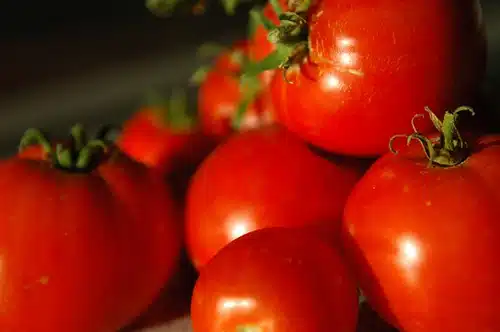Tomatoes are one of the most popular vegetables grown in gardens and fields around the world. With over 10,000 varieties to choose from, it can be overwhelming to select the right ones for your culinary needs. For those looking to make their own homemade tomato paste, selecting the best type of tomato is crucial. In this article, we will explore nine of the best tomatoes to grow for paste-making purposes.
When it comes to growing tomatoes for paste, there are several factors that should be taken into consideration such as texture, flavor profile, and yield. The ideal tomato should have a dense flesh with low water content and a sweet yet tangy flavor that can hold up when cooked down into a thick paste. Additionally, high-yielding varieties are preferred for larger batches of paste. By selecting the right tomato variety for your needs and growing conditions, you can produce a flavorful homemade tomato paste that will elevate your dishes to new heights.
Understanding The Importance Of Tomato Selection For Paste-Making
Tomato paste is a staple ingredient in many cuisines worldwide. It’s used as a base for sauces, soups, stews, and other dishes. While it’s widely available in stores, homemade tomato paste offers several benefits over store-bought options. Homemade paste has a richer flavor and is free of artificial preservatives, additives, and chemicals.
Using the right tomatoes to make paste is crucial to achieving the best results. The ideal tomatoes for making paste are meaty with few seeds and lots of flesh. Tomatoes that fit this description include Roma, San Marzano, Amish Paste, and Jersey Devil varieties. Choosing the right tomato variety ensures that the resulting paste has a thick consistency with minimal water content.
When using tomato paste in cooking, it’s essential to remember that it’s highly concentrated compared to fresh tomatoes. As such, you should use it sparingly to avoid overpowering your dish with its intense flavor. One way to incorporate tomato paste into your dishes is by diluting it with broth or water before adding it to your recipe. This strategy helps distribute the flavor evenly throughout the dish while preventing clumping.
Factors To Consider When Choosing Tomatoes For Paste
Understanding the Importance of Tomato Selection for Paste-Making has enlightened us on the significance of choosing the right kind of tomato for our paste. Now, we will delve deeper into Factors to Consider When Choosing Tomatoes for Paste. It is not enough to simply know that we need a specific type of tomato; we need to understand how various factors influence our decision.
Firstly, Growing Techniques play an important role in determining which tomatoes are best suited for your paste-making needs. For instance, determinate tomatoes are great for those who have limited space as they grow compactly and require little support. Indeterminate tomatoes, on the other hand, have a longer growing season and produce fruit throughout the season. Understanding these differences will help you choose the right tomato variety for your particular situation.
Secondly, Flavor Profile should be considered when selecting a tomato for your paste. Tomatoes with a high acidity level tend to make better paste as they have a more robust flavor profile. Furthermore, ensure you select a variety that is meaty and has fewer seeds as this will result in less water content in your final product.
Lastly, Seed Selection and Yield Potential should also be considered when selecting a tomato variety for your paste making endeavors. Choose seeds from reputable suppliers who guarantee high germination rates and take into account the plant’s yield potential to ensure that you get enough fruit for your needs.
Roma tomatoes: The classic choice for paste-making enthusiasts everywhere. These oblong-shaped tomatoes are meaty with few seeds and low water content making them perfect for making thick and flavorful paste. In the next section, we will explore Roma tomatoes further and provide insight into why they remain one of the most popular choices among home gardeners today.
Roma Tomatoes: The Classic Choice For Paste
When it comes to making tomato paste, the choice of tomato variety is crucial. One of the most popular choices for paste making is Roma tomatoes. These oblong-shaped tomatoes have a dense and meaty flesh that makes them ideal for processing into paste. Besides their suitability for paste making, there are several other benefits of using Roma tomatoes.
Firstly, Roma tomatoes are high in pectin, a natural thickener that gives tomato paste its characteristic consistency. Compared to other tomato varieties, Romas have a higher concentration of pectin, which means less cooking time and less need for additional thickeners like cornstarch or flour. Secondly, Romas have fewer seeds and less water content than other types of tomatoes. This makes them easier to process into paste without diluting the flavor or texture.
While Roma tomatoes are the classic choice for making tomato paste, there are alternative varieties worth considering. San Marzano tomatoes, for instance, are an Italian heirloom variety that is prized for its rich flavor and low acidity. Other options include Amish Paste, Pink Oxheart, and Black Plum tomatoes. Each variety has its unique qualities that can add depth and complexity to your homemade pasta sauce or soup.
Next up on our list of best tomato varieties for paste making is San Marzano tomatoes: the Italian favorite. These elongated plum-shaped tomatoes have a sweet and tangy taste that makes them perfect for traditional Italian dishes like pizza margherita and spaghetti alla puttanesca. In the next section, we’ll explore why San Marzanos are so highly regarded by chefs and home cooks alike when it comes to making delicious tomato-based sauces and pastes.
San Marzano Tomatoes: The Italian Favorite
San Marzano Tomatoes are believed to have originated in the volcanic soil near Mount Vesuvius in Italy. There are several varieties of San Marzano Tomatoes, including the San Marzano Redorta, Fiaschetto, and Cuore di Bue. San Marzano Tomatoes have a unique taste, with the combination of a mild sweetness and tartness. The flavor is often described as a combination of smokiness, acidity, and sweetness. San Marzano Tomatoes are ideal for making sauces, soups, and other tomato-based dishes. The tomatoes are also often used in a variety of Italian dishes, including pizza and pasta. San Marzano Tomatoes are considered one of the best varieties of tomatoes to grow for paste.
Origin
Tomato paste has a long and storied history, with its origins dating back to ancient Rome. It was commonly used as a way to preserve tomatoes and make them last longer. Today, tomato paste is widely used in cooking as a base for sauces, soups, and stews. To make the best tomato paste, it’s important to choose the right type of tomato for the job.
One of the most popular types of tomatoes for making paste is the San Marzano tomato. Originating from Italy, these tomatoes are known for their elongated shape and rich flavor. They are typically grown in the Campania region of Italy, which is known for its fertile soil and ideal growing conditions. However, San Marzano tomatoes can also be grown in other regions around the world with similar conditions.
When it comes to growing San Marzano tomatoes for paste, it’s important to choose a location with plenty of sunshine and well-draining soil. These plants require regular watering but should not be overwatered, as this can lead to disease and other problems. With proper care and attention, San Marzano tomatoes can yield an abundant harvest that is perfect for making delicious homemade tomato paste.
Varieties
San Marzano tomatoes are a favorite among Italian chefs and home cooks around the world. These elongated, flavorful tomatoes are ideal for making tomato paste due to their texture and taste. However, there are several varieties of San Marzano tomatoes that one can choose from when growing them in their garden or purchasing seeds.
Seed sources for San Marzano tomatoes vary depending on location and availability. Some popular seed companies that offer San Marzano tomato seeds include Burpee, Baker Creek, and Johnny’s Selected Seeds. It’s important to choose a reputable source that offers high-quality seeds to ensure a successful harvest.
When it comes to growing San Marzano tomatoes, there are several techniques that can be used to maximize yield and flavor. These include planting in well-draining soil with plenty of sunshine, providing regular watering but avoiding overwatering, using organic fertilizers, and pruning the plants to promote fruit production. Additionally, it’s important to monitor for pests and diseases regularly to prevent damage to the plants.
In conclusion, choosing the right variety of San Marzano tomato and utilizing proper growing techniques can lead to an abundant harvest of delicious tomatoes that are perfect for making homemade tomato paste. By sourcing high-quality seeds and following best practices in gardening, anyone can enjoy the rich taste and texture of these Italian favorites in their own backyard or kitchen.
Taste
Exploring flavor is one of the joys of cooking with San Marzano tomatoes. These elongated, meaty tomatoes are known for their rich flavor and low acidity, which makes them perfect for sauces and tomato pastes. The taste profile of San Marzano tomatoes is often described as sweet and slightly tangy, with a deep umami flavor that comes from their high levels of glutamic acid. When cooked down into a sauce or paste, San Marzano tomatoes add a depth of flavor that cannot be replicated by other tomato varieties.
Pairing San Marzano tomatoes with pasta is a classic Italian combination that has been enjoyed for generations. The sweetness and richness of the tomato sauce complement the starchy base of the pasta, creating a balanced and satisfying dish. When making pasta sauce with San Marzano tomatoes, it’s important to let the flavors develop slowly over time, allowing the natural sweetness of the tomatoes to shine through. Adding fresh herbs like basil or oregano can enhance the flavor even further, creating a complex sauce that elevates any pasta dish.
In summary, exploring the flavor possibilities of San Marzano tomatoes is an exciting journey for any home cook or chef. Their unique taste profile makes them ideal for pairing with pasta dishes and creating homemade tomato paste or sauces. By using high-quality seeds and proper growing techniques, anyone can enjoy the delicious taste of these Italian favorites in their own kitchen.
Amish Paste Tomatoes: The Heirloom Wonder
San Marzano tomatoes may be the Italian favorite for making paste, but there are other varieties worth considering. One such option is the Amish Paste tomato, an heirloom wonder that has been grown by Amish farmers for generations. Unlike hybrid tomatoes, which are bred for disease resistance and high yield, heirloom tomatoes are open-pollinated and have a rich history of cultivation.
When it comes to growing Amish Paste tomatoes, it’s important to note that they can thrive in different climates. These plants do well in warm weather, but they’re also tolerant of cooler temperatures. Additionally, Amish Paste tomatoes require full sun exposure and consistent watering throughout their growing season. With proper care and attention, these plants can produce juicy fruits that are ideal for making paste.
Heirloom vs. hybrid tomatoes is a topic of much debate among tomato enthusiasts. While hybrids may offer some advantages in terms of disease resistance and yield, many gardeners prefer the unique flavors and characteristics of heirloom varieties like the Amish Paste tomato. Whether you’re a seasoned gardener or just starting out, experimenting with different tomato varieties can be a rewarding experience that yields delicious results.
As we move on to discuss opalka tomatoes: the meaty marvels of the paste world, it’s important to remember that there are many options available when it comes to selecting the perfect tomato variety for your needs. By exploring different types of tomatoes and experimenting with growing techniques in your own garden or greenhouse environment, you can discover new flavors and textures that will make your homemade pasta sauces truly unforgettable.
Opalka Tomatoes: The Meaty Marvel
Opalka tomatoes are one of the best paste tomato varieties to grow for their high meat content and firm texture. These elongated, sausage-shaped fruits can reach up to 6 inches in length, making them perfect for slicing or dicing for sauces or soups. With a rich flavor that is both sweet and tangy, Opalka tomatoes are a favorite among gardeners and chefs alike.
Aside from their delicious taste, Opalka tomatoes have numerous benefits that make them an excellent choice for any home gardener. For one, they are known to be disease-resistant, making them less prone to fungal infections or blight. Additionally, their thick skin helps protect against cracking or splitting during periods of heavy rainfall or high humidity. And with their meaty flesh, they produce less water content than other tomato varieties, making them ideal for use in pasta dishes or stews.
If you’re looking for ways to incorporate Opalka tomatoes into your cooking routine, there are plenty of recipe options available online. From classic marinara sauces to roasted tomato soups, these meaty paste tomatoes add depth and flavor to any dish. You can also try canning your own tomato sauce or salsa using fresh Opalka tomatoes from your garden.
Transition:
Next up on our list of the best paste tomato varieties is the Federle tomato – a small but mighty option that packs a flavorful punch. Let’s dive in and explore this versatile fruit in more detail.
Federle Tomatoes: The Small But Mighty Option
With their unique flavor profile and meaty texture, Opalka tomatoes are a popular choice for making paste. But if you’re looking for a smaller option that packs just as much punch, consider the Federle tomatoes. These little gems may be small in size but they are mighty in flavor and yield.
The Federle tomato plant is compact and produces an abundance of elongated fruits that have a rich, sweet taste. They are perfect for making paste because of their high flesh-to-seed ratio. Additionally, they are disease-resistant and can thrive in both hot and cool climates.
If you want to grow Federle tomatoes successfully, there are a few tips to keep in mind. They prefer well-draining soil with plenty of organic matter added in. You’ll also want to give them plenty of sunlight and water regularly. To avoid disease, it’s best to stake or cage them so the fruit doesn’t touch the ground.
Now that we’ve covered the small but mighty Federle tomato option, let’s move onto another flavorful alternative: costoluto genovese tomatoes. These Italian heirloom tomatoes have a distinct ribbed appearance and an intense flavor that makes them ideal for paste-making projects.
Costoluto Genovese Tomatoes: The Flavorful Alternative
When it comes to choosing the best tomatoes for making paste, there are a variety of options available. One such option is the Costoluto Genovese Tomato, which boasts a unique flavor profile that sets it apart from other tomato varieties. This Italian heirloom tomato is known for its large, ribbed shape and distinctive taste that is both sweet and tangy.
For those looking to incorporate this flavorful alternative into their cooking applications, the Costoluto Genovese Tomato can be used in a variety of ways. Its meaty texture makes it perfect for sauces and pastes, while its juicy flesh can also be used in salads or sliced for sandwiches. Additionally, its distinct flavor profile adds depth to any dish it is included in.
If you are looking to experiment with new tomato varieties in your garden this year, consider adding the Costoluto Genovese Tomato to your lineup. Its unique attributes make it a valuable addition for any home cook or gardener seeking to expand their culinary horizons.
Transitioning into the subsequent section about black plum tomatoes: the unique option, gardeners may be interested in exploring another flavorful alternative to traditional paste tomatoes. Black Plum Tomatoes offer a distinct flavor and texture that can elevate any dish they are used in.
Black Plum Tomatoes: The Unique Option
The Black Plum tomato, also known as the Italian Oxheart, is a unique option for those looking to grow paste tomatoes. These tomatoes are known for their distinctive shape and deep red color. The name “plum” comes from the elongated shape of the fruit, which can be up to four inches long.
One of the most appealing aspects of Black Plum tomatoes is their unique flavor. They have a sweet yet tangy taste that sets them apart from other varieties of paste tomatoes. This makes them an excellent choice for cooking applications such as making tomato sauce or paste. Their firm flesh also makes them ideal for canning.
These hearty plants require full sun and well-draining soil to thrive. They are generally disease-resistant and can produce a high yield of fruit per plant. With their exceptional flavor and versatility in cooking applications, Black Plum tomatoes are an excellent choice for any home gardener looking to add a unique twist to their tomato harvest.
Transitioning into the subsequent section about orange Roma tomatoes: the colorful twist, these vibrant fruits offer a striking alternative to traditional red paste tomatoes.
Orange Roma Tomatoes: The Colorful Twist
Orange Roma tomatoes offer a unique twist on the classic tomato, being characterized by its attractive deep orange hue and notable sweet flavor. These tomatoes are also known for their dense texture, making them excellent for use in sauces, pastes, and other recipes. Orange Roma tomatoes are easy to grow, particularly in areas with warm climates and long growing seasons. As such, these tomatoes are a great choice for gardeners looking for a flavorful and colorful variety for their tomato garden.
Orange Roma Tomatoes
Orange Roma tomatoes are an excellent addition to any garden for those looking to add a colorful twist to their paste-making process. These tomatoes are oblong and slightly larger than traditional Roma tomatoes, with a bright orange color that adds a pop of vibrancy to any dish. Not only do they offer aesthetic appeal, but they also provide unique flavor profiles that can enhance recipes using orange Roma tomatoes.
Recipes using orange Roma tomatoes can range from classic pasta sauces to more unconventional dishes like tomato jam or chutney. The bold color provides an eye-catching visual element that is sure to impress guests and elevate the overall presentation of the dish. Furthermore, the sweetness of these tomatoes pairs well with savory spices and herbs, allowing for endless possibilities in terms of flavor combinations.
The benefits of using different colored tomatoes for paste making cannot be overstated. While traditional red varieties are certainly delicious, incorporating other colors into your recipes can add depth and complexity to the final product. Orange Roma tomatoes are particularly useful in this regard since their bright hue stands out against other ingredients and adds a unique touch to any recipe. Overall, growing orange Roma tomatoes is an excellent way to diversify your garden and add new flavors and colors to your culinary creations.
Colorful Varieties
Seed selection is an essential aspect of tomato gardening that can affect the final product’s taste, texture, and appearance. Colorful varieties, such as orange Roma tomatoes, offer a unique twist to traditional red tomatoes and are worth considering for gardeners looking to add some diversity to their harvest. These oblong-shaped tomatoes have a bright orange color that adds vibrancy to any dish.
When selecting seeds for colorful varieties like orange Roma tomatoes, it’s important to choose reputable seed companies that provide high-quality seeds. Gardeners should consider factors such as disease resistance, fruit size, and yield when making their selection. Additionally, proper growing techniques must be followed to ensure a healthy crop of flavorful and visually appealing tomatoes.
Growing colorful tomato varieties requires similar techniques as growing traditional ones. However, it’s important to note that different colored tomatoes may require varying levels of sunlight exposure and watering schedules. Gardeners should also pay attention to soil pH levels and nutrient composition when planting these varieties. With proper care and attention to detail, gardeners can enjoy a bountiful harvest of colorful and delicious tomatoes from their garden.
Determinate Vs. Indeterminate Tomatoes For Paste
Differences between determinate and indeterminate tomatoes for paste are important to consider when choosing which type to grow. Determinate tomatoes, also called bush tomatoes, have a predetermined growth pattern that results in a more compact plant that stops growing once it sets fruit. Indeterminate tomatoes, on the other hand, continue to grow and produce fruit throughout the season until frost or disease kills them.
Pros and cons of each tomato type for paste making should also be considered. Determinate tomatoes are often preferred for paste making because they tend to ripen all at once, making them ideal for large-scale production. However, indeterminate varieties can also be used for paste making as they tend to have a higher yield overall and can produce fruit well into the fall season.
It is important to note that there are many different varieties of both determinate and indeterminate tomatoes that can be suitable for paste making. When choosing which type to grow, it is best to consider factors such as plant size, yield, disease resistance, and flavor profile. Ultimately, the decision between determinate and indeterminate varieties will depend on individual preferences and growing conditions. In the subsequent section about growing tomatoes for paste in containers, we will explore how these factors can affect container gardening specifically.
Growing Tomatoes For Paste In Containers
Did you know that tomatoes grown in containers can produce just as much fruit as those grown in the ground? In fact, container gardening is becoming increasingly popular among urban gardeners and those with limited space. If you’re interested in growing tomatoes for paste but don’t have a lot of outdoor space, consider growing them in containers.
When choosing containers for your tomato plants, size matters. Tomatoes have deep roots and require a large container to thrive. A container at least 18-24 inches deep and wide is recommended to ensure sufficient room for root growth. Additionally, the soil type used in your containers will play a crucial role in the success of your tomato plants. Use a well-draining soil mix with plenty of organic matter to ensure healthy root development.
Growing tomatoes for paste in containers requires some extra attention compared to traditional ground gardening methods. However, the benefits are undeniable; it’s an excellent way to maximize yield and quality while minimizing space usage. By using appropriate container sizes and soil types, you’ll be on your way to producing delicious homegrown paste tomatoes in no time!
For even greater success, there are several tips for maximizing yield and quality that you should follow. These include proper watering techniques, regular fertilization, controlling pests and diseases, pruning the plants regularly, and providing adequate support for heavy fruiting branches. With these tips, you’ll be able to grow an abundant harvest of tasty paste tomatoes right from your own balcony or patio!
Tips For Maximizing Yield And Quality
To maximize yield and quality when growing paste tomatoes, there are a few tips to keep in mind. First, ensure proper spacing between plants to allow for adequate airflow and sunlight penetration. This helps prevent diseases and promotes fruit development. Additionally, regular pruning of suckers and lower leaves can help redirect energy towards fruit production.
Maximizing flavor in paste tomatoes can be achieved through various techniques. One method is to wait until the fruits are fully ripe before harvesting them. This allows for maximum sugar development, resulting in sweeter tomatoes with richer flavors. Another technique is to roast or slow cook the tomatoes before using them in recipes. This intensifies their flavor and adds depth to dishes.
Preserving techniques are essential for making the most out of your harvest. Canning is a popular method for preserving large quantities of paste tomatoes. Alternatively, freezing can also be a convenient option for smaller batches. Drying tomatoes is another preservation method that concentrates their flavor, making them ideal for use in sauces or as toppings on pizzas.
- To truly savor the flavors of your paste tomatoes, try roasting them with garlic and herbs.
- For an easy weeknight dinner, toss cooked pasta with fresh chopped paste tomatoes and basil.
- Experiment with different tomato varieties to discover unique flavor profiles.
- Don’t be afraid to get creative with your tomato preservation methods – try pickling or making homemade ketchup!
Moving onto the next step of tomato gardening – harvesting and storing tomatoes for paste – it’s important to handle the fruits carefully to avoid bruising or damaging them.
Harvesting And Storing Tomatoes For Paste
Harvesting tips are essential to ensure that the tomatoes are at their peak flavor when they’re picked. When it comes to paste tomatoes, it’s crucial to wait until they’re fully ripe before harvesting. This will allow them to have a more concentrated flavor, which is ideal for making tomato paste. The best time to pick them is when they’ve turned a deep red color and are slightly soft to the touch.
After harvesting, it’s important to store the tomatoes properly. One of the best storage methods is canning. Canning allows you to preserve the taste of your freshly harvested tomatoes for up to a year. Another great storage method is freezing. By blanching the tomatoes first, you can easily remove their skins and then freeze them in airtight containers or freezer bags.
In summary, harvesting and storing your paste tomatoes correctly is crucial for making delicious homemade tomato paste. Remember to wait until they’re fully ripe before picking, and then store them using one of the recommended methods such as canning or freezing. In the next section, we’ll explore some mouth-watering recipes for using your homemade tomato paste in all sorts of dishes!
Delicious Recipes For Homemade Tomato Paste
After harvesting and storing tomatoes, the next step for tomato enthusiasts is to make delicious homemade paste. But before we dive into creative recipes, preserving tomato paste is crucial to ensure its shelf life. There are different methods for preserving tomato paste such as freezing, canning, or dehydrating. Freezing is the easiest method but may alter the texture of the paste. Canning requires more effort and equipment but results in a longer shelf life. Dehydrating produces a concentrated paste that can be stored for a long time.
Now that we have covered preservation techniques, let’s explore some creative uses for homemade tomato paste. Tomato paste is a versatile ingredient that can be used in various dishes such as soups, stews, pasta sauces, meatballs, and more. It adds depth and richness to any recipe and enhances the flavor profile of other ingredients. For example, adding tomato paste to a beef stew will create a more complex taste profile than using only fresh tomatoes.
Incorporating homemade tomato paste into your cooking will not only elevate your dishes but also provide health benefits. Tomatoes are rich in vitamins A and C and contain lycopene which has antioxidant properties. With these tips on preservation techniques and creative uses for homemade paste, you’re now equipped to take your culinary skills to the next level!
Conclusion
Selecting the right tomatoes for paste-making is a crucial aspect of successful gardening. A variety of factors must be considered, including taste, texture, and yield. Roma tomatoes are a classic choice that produces thick flesh with minimal seeds, while San Marzano tomatoes are the go-to option for Italian cuisine due to their sweet flavor and low acidity. Amish Paste tomatoes are also an excellent heirloom option with a unique flavor profile.
When growing tomatoes for paste, it is essential to provide adequate support and soil nutrients to maximize yield and quality. Even those limited by space can grow paste tomatoes in containers with proper care. Harvesting at the right time and storing appropriately will allow you to enjoy home-made tomato paste all year round.
In conclusion, selecting the best tomatoes for paste-making is crucial for both experienced gardeners and beginners alike. By considering factors such as taste, texture, yield, and growth conditions when choosing your plants, you can enhance your gardening experience while producing high-quality tomato paste that will delight your taste buds. With these tips in mind, you can enjoy delicious homemade tomato paste all year round and impress your guests with delectable dishes made from fresh produce grown right in your backyard.
Image Credits
- “Tomatoes” by St0rmz (featured)





























